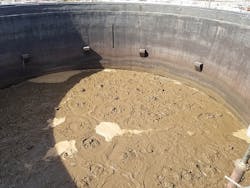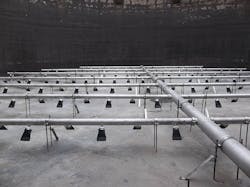The Lackawanna River Basin Sewer Authority’s Wastewater Treatment Facility in Archbald, Pa., was facing problems with its fine bubble aeration system. An older facility built in the 1970’s, the plant had implemented several upgrades over the years to improve sludge thickening, dewatering and its aerobic digestion processes.
The facility’s two equalization tanks were originally used as anaerobic digesters, which did not require aeration mixing. Over time, the tanks were converted to aerobic digesters, and retrofitted with fine bubble aeration mixing systems. While these upgrades improved the plant’s ability to concentrate solids and reduce the volume of sludge to process, the original fine bubble aeration system experienced clogging problems, even though many of its parts had been replaced or upgraded over the years.
The facility needed to consistently improve and increase its solids concentration–from 1% to 2%, up to 4%–in its tanks, but the fine bubble diffuser system was not designed to handle the higher sludge concentration. Fouling also eventually occurred, since no backflow prevention was built into the original diffuser system design. This created the need for additional maintenance, as well as loss in performance for the process.
As a result of the ongoing clogging problems, solids frequently built up in the tanks, causing odor due to hydrogen sulfide formation. This problem led to more downtime, as tanks would require intermittent cleaning since solids could not be re-suspended within the entire tanks.
Complex Problem, Simple Solution
After carefully reviewing how to solve these problems, the Lackawanna River Basin Sewer Authority made the decision to install the Tideflex® Aeration and Mixing System. The system is completely sealed, restricting surrounding wastewater and solids from infiltrating its diffusers and manifold piping.
The system also provides built-in backflow prevention. Since the system can be installed within a few inches from the tank floor, the system efficiently isolates wastewater while maximizing mixing and also can be operated in an on and off mode to reduce energy costs.
After only a few years, the results have shown an improvement. In the sludge holding tank, the solids now are operating from 0.7% to 1.5%. In the aerobic digester, solids concentration is driven to 4% and sometimes as high as 5%.
“The Tideflex® Aeration and Mixing System was able to improve performance and reduce maintenance by virtually eliminating the clogging issues we had experienced in the past, along with increasing our ability to control overall plant operations and process,” said Bob Davis, Plant Superintendent.
In addition to installing the Tideflex® Aeration and Mixing System, other supporting systems were upgraded, including polymer feed, dewatering equipment and sludge pumping systems to improve sludge thickening, dewatering and aerobic digestion processes. The overall result has been trouble-free operations and significantly reduced operating costs.
Editor's Note: Scranton Gillette Communications and the SGC Water Group are not liable for the accuracy, efficacy and validity of the claims made in this piece. The views expressed in this content do not reflect the position of the editorial teams of Water & Wastes Digest, Water Quality Products and Storm Water Solutions.

